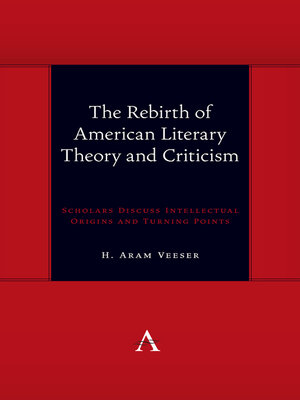The Rebirth of American Literary Theory and Criticism
ebook ∣ Scholars Discuss Intellectual Origins and Turning Points · Anthem symploke Studies in Theory
By H. Aram Veeser

Sign up to save your library
With an OverDrive account, you can save your favorite libraries for at-a-glance information about availability. Find out more about OverDrive accounts.
Find this title in Libby, the library reading app by OverDrive.



Search for a digital library with this title
Title found at these libraries:
| Library Name | Distance |
|---|---|
| Loading... |
The interviewees of this volume fall into three groups: the main players who brought about the rise of theory (Fish, Gallop, Spivak, Bhabha); a younger group of post-theorists (Bérubé, Dimock, Nealon, Warren); the anti-critique theorists (Felski); and new order theorists (Puchner, Wolfe). They discuss elemental questions, such as trying to grasp what was logic and what was rhetoric; trying to see down the road while fog and turmoil held visibility to arm's length; and trying to pick legible meanings out of the cultural blanket of deafening noise. Theorists were not only good thinkers but also pioneers who were seeking profound transformations.
|This book is the first collection of unified interviews with the great figures of the golden age of American celebrity literary and cultural critics. While many of these celebrity critics have been interviewed elsewhere, this collection is different. The 18 critics interviewed here are all asked the same questions, whereas usually interviews are one-offs, each one unique and incomparable. By contrast this collection shows that theorists, when commenting on the same issues, actually range widely and express a remarkable diversity of opinions.
The book also presents a vivid portrayal of the ways in which literary theory affected the lives of these individuals. All 18 people interviewed lived what might be called, without exaggeration, a life of theory. Their work and lives were jostled by seismic dislocations. New criticism was overwhelmed by postmodernism, deconstruction reigned and then succumbed to new historicism and the politics and criticism of identity. Race and gender burgeoned as fundamental topics. Critics and scholars experiences these ruptures differently and reacted in different ways. This book of interviews offers 18 exemplary instances. Instead of the unity they are often assumed to have, these figures reveal how incredibly diverse they actually were.
Finally, the collection offers a coherent summation of this richly turbulent and intellectually powerful era. The introduction to the volume and the brilliant afterword by Professor Heather Love offer cogent assessment of this remarkably varied era of American intellectual life. They make sense of a disruptive and puzzling past. The book includes 23 illustrations highlighting some of the key points and themes.







